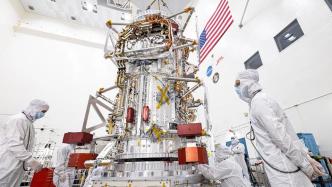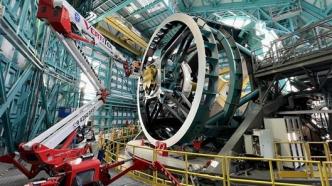

Mosquitoes produced at the World Mosquito Project factory.

NASA spacecraft visiting Europa.

Vera Rubin Observatory in Chile.
Advanced artificial intelligence tools, lunar missions and ultra-fast supercomputers will shape scientific research in the coming year. On December 18, "Nature" magazine took stock of scientific events worthy of attention in 2024.
Advances in Artificial Intelligence
The rise of ChatGPT has had a profound impact on scientific developments this year. Its creator, the American artificial intelligence research company OpenAI, is expected to release GPT-5, the next generation artificial intelligence model of the chatbot, later in 2024. GPT-5 will likely demonstrate more advanced capabilities than its predecessor, GPT-4. Scientists are also paying attention to the appearance of GPT-4’s competitor Gemini.
Large language models can handle many types of input, including text, computer code, images, and audio and video.
A new version of AlphaFold, the artificial intelligence tool of Google DeepMind in the United States, will also be released in 2024. Researchers have used it to predict the 3D shape of proteins with high accuracy. Over the next year, artificial intelligence will model interactions between proteins, nucleic acids and other molecules with atomic precision, which could open new pathways for drug design and discovery.
At the same time, it is urgent to resolve regulatory issues. The United Nations High-Level Advisory Body on Artificial Intelligence will publish its final report in mid-2024 to issue guidelines for the international regulation of artificial intelligence.
aim for the stars
Chile's Vera Rubin Observatory plans to have some of its instruments operational by the end of 2024. With the observatory's 8.4-meter telescope and 3.2-billion-pixel camera, scientists hope to discover more new transient phenomena and near-Earth asteroids.
Also in Chile, the Simons Observatory will be completed in mid-2024. This next-generation cosmology experiment will search for signatures of primordial gravitational waves in the cosmic microwave background. Its telescope will be equipped with up to 50,000 light-gathering detectors, 10 times more than similar projects currently underway.
Astronomers remain concerned that new ground-based telescope data may be harder to come by as a growing constellation of bright satellites is polluting the night sky with light.
"Armed" mosquitoes
The World Mosquito Project will produce disease-resistant mosquitoes at a factory in Brazil in 2024. The mosquitoes will carry a bacterium that prevents mosquitoes from transmitting disease-causing viruses, potentially protecting up to 70 million people from diseases such as dengue fever and Zika.
The nonprofit plans to produce up to 5 billion disease-resistant mosquitoes per year over the next 10 years.
Outside the epidemic
In response to the new coronavirus epidemic, the U.S. government is funding trials of three next-generation vaccines. Two of them are intranasal vaccines that prevent infection by creating immunity in the airway tissue. The third is an mRNA vaccine that can enhance antibody and T cell responses and is expected to achieve long-lasting immunity against new coronavirus variants.
The World Health Organization will publish the final draft of its epidemic treaty at the 77th World Health Assembly in May 2024. The treaty aims to enable governments to better prevent and manage future pandemics.
lunar mission
Since the 1970s, NASA has once again launched a manned mission to the moon. Artemis 2 may be launched as early as November 2024, and will carry a total of four astronauts, 3 men and 1 woman, on the Orion spacecraft for a 10-day flight around the moon.
In addition, NASA's "Clipper" spacecraft will fly to Jupiter's moon Europa in October 2024. Japan plans to launch a Mars satellite exploration mission in 2024. It will visit the Mars satellites Phobos and Deimos. Its probe will land on Phobos and collect surface samples.
'Illuminating' dark matter
An experiment to detect dark matter particles called "axions" will see the light of day in 2024. Axions are thought to be emitted by the Sun and converted into light, but they have not yet been observed experimentally because this would require sensitive detection tools and extremely strong magnetic fields.
The BabyIAXO experiment at the Electron Synchrotron in Germany uses a solar telescope consisting of a 10-meter-long magnet and an ultra-sensitive noise-free X-ray detector to track the center of the Sun 12 hours a day to capture the conversion of axions into photons.
Additionally, 2024 may be the year scientists determine the mass of neutrinos. Neutrinos are the most mysterious particles in the Standard Model of particle physics. Researchers will complete data collection in 2024 and are expected to make unambiguous measurements of these tiny particles.
The debate about consciousness
In 2024, scientists may have new insights into the neural basis of consciousness. A large project is testing two theories of consciousness through a series of adversarial experiments, with results from a second round expected to be announced by the end of 2024.
In a first round of experiments, neither theory was fully consistent with observed brain imaging data. A second round of experiments may bring neuroscience closer to deciphering the mysteries of subjective experience.
save the earth
In the second half of 2024, the International Court of Justice in The Hague is likely to issue an opinion on the legal obligations of countries to deal with climate change and rule on the legal consequences for those countries deemed to be damaging the climate. While the ruling is not legally binding, it could push countries to speed up their climate goals and be cited in domestic legal cases.
Since the 1950s, 10 billion tons of plastic have been produced globally, of which more than 7 billion tons have now become waste. Intergovernmental negotiations for the United Nations Plastics Treaty will conclude in 2024. The treaty aims to establish a binding international agreement to eliminate plastic pollution.
ultra-fast supercomputer
In early 2024, researchers will launch Jupiter, Europe's first exascale supercomputer. This huge machine can perform 10 billion calculations per second. Researchers will use the machine to create "digital twin" models of the human heart and brain for medical purposes and to perform high-resolution simulations of Earth's climate.
U.S. researchers will install two exascale computers in 2024 - Aurora at Argonne National Laboratory and El Capitan at Lawrence Livermore National Laboratory. Scientists will use Aurora to map neural circuits in the brain and El Capitan to simulate the effects of a nuclear weapon explosion.


